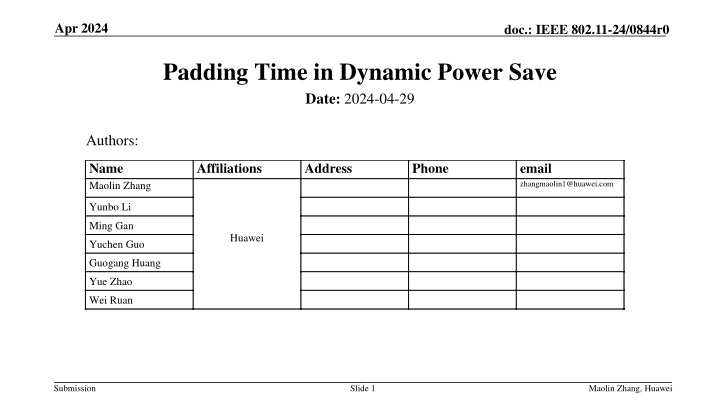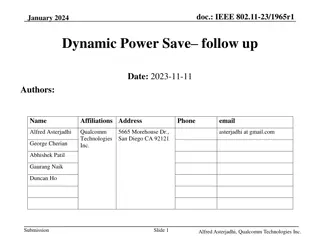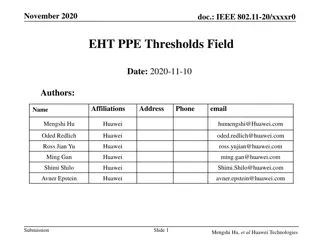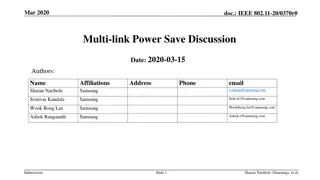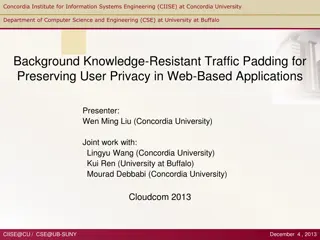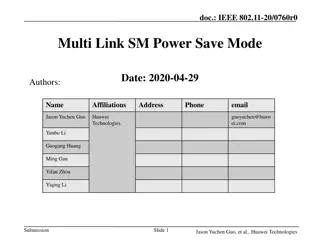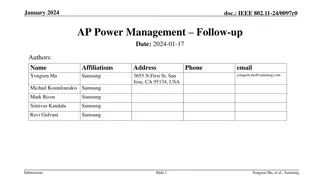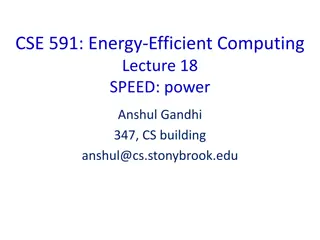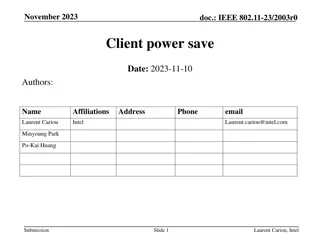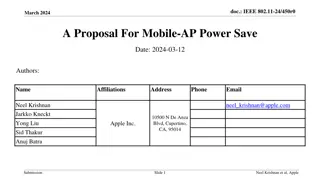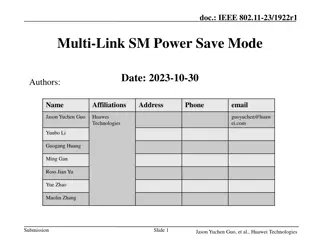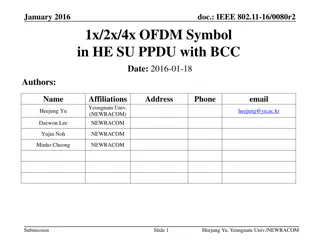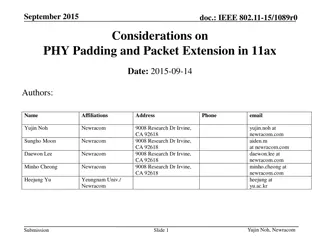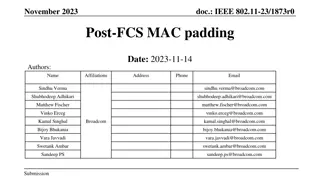Padding Time in Dynamic Power Save
This document discusses the padding time considerations in dynamic power save mechanisms for IEEE 802.11-24 standards. It addresses the need to adjust padding settings for bandwidth switching, ensuring efficient capability transitioning with minimal latency during low-power operations.
Download Presentation

Please find below an Image/Link to download the presentation.
The content on the website is provided AS IS for your information and personal use only. It may not be sold, licensed, or shared on other websites without obtaining consent from the author.If you encounter any issues during the download, it is possible that the publisher has removed the file from their server.
You are allowed to download the files provided on this website for personal or commercial use, subject to the condition that they are used lawfully. All files are the property of their respective owners.
The content on the website is provided AS IS for your information and personal use only. It may not be sold, licensed, or shared on other websites without obtaining consent from the author.
E N D
Presentation Transcript
Apr 2024 doc.: IEEE 802.11-24/0844r0 Padding Time in Dynamic Power Save Date: 2024-04-29 Authors: Name Maolin Zhang Affiliations Address Phone email zhangmaolin1@huawei.com Yunbo Li Ming Gan Huawei Yuchen Guo Guogang Huang Yue Zhao Wei Ruan Submission Slide 1 Maolin Zhang, Huawei
Apr 2024 doc.: IEEE 802.11-24/0844r0 Introduction Low power listen mode was proposed by [1]. References[2-6] continue to develop the low power listen mode to dynamic power save (DPS) and provide more details. References[4, 5, 7] propose to add a new Intermediate FCS field before the padding so that the STA can use the padding time to change bandwidth (BW). Submission Slide 2 Maolin Zhang, Huawei
Apr 2024 doc.: IEEE 802.11-24/0844r0 Motivation Compared with EMLSR, dynamic power save introduces bandwidth switching. Due to the introduction of bandwidth switching, the padding settings need to be reconsidered. Bandwidth switching requires recalibration of phase-locked loop (PLL) and RF, which takes a longer time [8]. Changing NSS/MCS only takes microseconds, while changing BW takes hundreds of microseconds. (It varies depending on implementation. Low-cost devices take even longer to change BW.) Changing bandwidth depends on channel conditions and is therefore uncertain. When considering the setting of the padding time, it is necessary to ensure that the capability switching is completed during the padding time, and it is also expected that the padding time should be as short as possible to achieve low-latency dynamic power save, thus helping DPS to be applied in a wider range of scenarios. When switching between different capability states, a unified padding time may produce unnecessary delays, because different capability (e.g., BW, NSS, MCS) adjustments require different transition times. Submission Slide 3 Maolin Zhang, Huawei
Apr 2024 doc.: IEEE 802.11-24/0844r0 Proposal: Padding Setting Procedure During the DPS capability reporting period, the STA reports transition delay information, including multiple padding times or a mapping table, for different capability adjustments. AP performs channel contention before transmitting the Initial Control Frame (ICF). AP selects one padding time based on channel availability and specific capability changes. AP transmits ICF with the padding (actual padding time indicated padding time). Transmitting ICF DPS Capability Reporting (Multiple Padding Times) Channel Contention Padding Time Selection Submission Slide 4 Maolin Zhang, Huawei
Apr 2024 doc.: IEEE 802.11-24/0844r0 Example. Multiple Padding Times Whether changing bandwidth results in different delays. [BW, NSS, MCS] Padding time = ?1 [BW, NSS, MCS] Padding time = ?1 [BW, NSS, MCS] Padding time = ?1 [BW, NSS, MCS] Padding time=?2 [BW, NSS, MCS] Padding time=?2 [BW, NSS, MCS] Padding time=?2 [BW, NSS, MCS] Padding time=?2 E.g. ?1=8 s ?2=512 s Submission Slide 5 Maolin Zhang, Huawei
Apr 2024 doc.: IEEE 802.11-24/0844r0 Summary In this contribution, we consider the setting of padding times to cope with the transition time in dynamic power save. Changing bandwidth depends on channel conditions and is therefore uncertain. Hence, we propose to set different minimum padding times for different capabilities transition. STA reports multiple padding times or a mapping table. Based on the actual situation, AP selects one as the minimum padding time. Classifying the padding time can reduce unnecessary delays in DPS, thus helping DPS to be applied in a wider range of scenarios. Submission Slide 6 Maolin Zhang, Huawei
Apr 2024 doc.: IEEE 802.11-24/0844r0 References [1] 11-22-1414-00-0uhr-low-power-listening-mode [2] 11-23-0010-00-0uhr-considerations-for-enabling-ap-power-save [3] 11-23-1875-01-00bn-power-save-proposal-for-non-ap-mobile-ap [4] 11-23-2003-00-00bn-client-power-save [5] 11-23-1965-00-00bn-dynamic-power-save-follow-up [6] 11-24-0485-00-00bn-low-power-listening-mode-for-clients [7] 11-23-1873-00-00bn-post-fcs-mac-padding [8] 11-23-1942-00-00bn-inter-ppdu-low-power-listening-scheme Submission Slide 7 Maolin Zhang, Huawei
